Video Lecture
Theory For Making Notes
Lorem ipsum dolor sit amet, consectetur adipiscing elit. Ut elit tellus, luctus nec ullamcorper mattis, pulvinar dapibus leo.
Practice Questions (Level-1)
Q.1
A beam of light starting from point A reflects from a mirror M and forms an image at B as shown in the same horizontal plane as A. For small angle of incidence i, AB is equal to

(a) iD (b) 2iD (c) 4iD (d) iD/2
Ans. (b)
Q.2
Two plane mirrors A and B are aligned parallel to each other as shown in figure. A light ray is incident at an angle of 30° at a point just inside one end of A. The plane of incidence coincides with the plane of the figure. The maximum number of times the ray undergoes reflections (including the first one) before it emerges out is
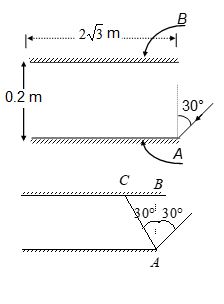
(a) 28 (b) 30 (c) 32 (d) 34
Ans. (b)
Practice Questions (Level-2)
Q.1
Two mirrors labeled L1 for left mirror and L2 for right mirror in the figure are parallel to each other and 3 m apart. A person standing x m from the right mirror L2 looks into this mirror and sees a series of images. The distance between the first and second image is 4 m. Then the value of x is
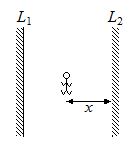
(a) 2 m
(b) 6 m
(c) 1 m
(d) 8 m
Ans (c)
Q.2
A person walks at a velocity v in a straight line forming an angle \displaystyle \theta with the plane of a plane mirror. The velocity \displaystyle {{v}_{{rel}}} with which he approaches his image?

(a) \displaystyle 2v\,\sin \theta
(b) \displaystyle v\,\sin \frac{\theta }{2}
(c) \displaystyle 2v\,\cos \theta
(d) \displaystyle v\,\cos \frac{\theta }{2}
Ans (a)
Q.3
Two plane mirrors are arranged at right angles to each other as shown in figure. A ray of light is incident on the horizontal mirror at an angle \displaystyle \theta . For what value of \displaystyle \theta the ray emerges parallel to the incoming ray after reflection from the vertical mirror?
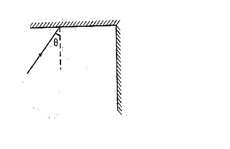
(a) 60º
(b) 30º
(c) 45º
(d) All of these
Ans (b)
Q.4
Two plane mirrors are inclined at angle as shown in figure. If a ray parallel to OB strikes the other mirror at P and finally emerges parallel to OA after two reflections then \displaystyle \theta is equal to
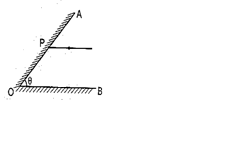
(a) 90º
(b) 60º
(c) 45º
(d) 30º
Ans (b)
Q.5
A man is walking under an inclined mirror at a constant velocity v along the x-axis. If the mirror is inclined at an angle with the horizontal then what is the velocity of the image?
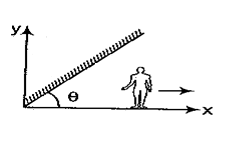
(a) \displaystyle v\,\sin \,\theta \,\hat{i}\,+\,v\,\cos \,\theta \hat{j}
(b) \displaystyle v\,\cos \,\theta \hat{i}\,+\,v\,\sin \,\theta \,\hat{j}
(c) \displaystyle v\,\sin \,2\theta \hat{i}\,+v\,\cos \,2\theta \hat{j}
(d) \displaystyle v\,\cos \,2\theta \hat{i}\,+\,v\,\sin \,2\theta \hat{j}
Ans (d)
Q.6
A person’s eye is at a height of 1.5 m. He stands infront of a 0.3 m long plane mirror whose lower end is 0.8 m above the ground. The length of the image he sees of himself is
(a) 1.5 m (b) 1.0 m (c) 0.8 m (d) 0.6 m
Ans. (d)
Q.7
Two plane mirrors A and B are parallel to each other and spaced 20 cm apart. An object is kept in between them at 15 cm from A. Out of the following, at which point image is not formed in mirror A (distance measured from mirror A)
(a) 15 cm (b) 25 cm (c) 45 cm (d) 55 cm
Ans. (c)
Q.8
A plane mirror is placed at origin parallel to y-axis, facing positive x-axis. An object starts from (2m, 0, 0) with a velocity of ( \displaystyle \left( {2\hat{i}+2\hat{j}} \right)\,m/s. The relative velocity of image with respect to object is along
(a) positive x-axis
(b) negative x-axis
(c) positive y-axis
(d) negative y-axis
Ans. (b)
Q.9
A ray is travelling along x-axis in negative x-direction. A plane mirror is placed at origin facing the ray. What should be the angle of plane mirror with the x-axis so that the ray of light after reflecting from the plane mirror passes through point (1m, \displaystyle \sqrt{3}\,m)?
(a) 30º (b) 60º (c) 45º (d) 90º
Ans. (b)
Q.10
A man is walking under an inclined mirror at a constant velocity v along the x-axis. If the mirror is inclined at an angle with the horizontal then what is the velocity of the image?
(a) \displaystyle v\,\sin \,\theta \,\hat{i}\,+\,v\,\cos \,\theta \hat{j}
(b) \displaystyle v\,\cos \,\theta \hat{i}\,+\,v\,\sin \,\theta \,\hat{j}
(c) \displaystyle v\,\sin \,2\theta \hat{i}\,+v\,\cos \,2\theta \hat{j}
(d) \displaystyle v\,\cos \,2\theta \hat{i}\,+\,v\,\sin \,2\theta \hat{j}
Ans. (d)
